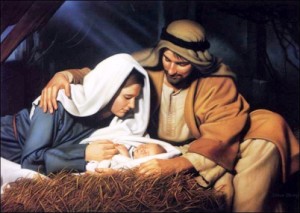 As we approach the solemnity of Christmas tomorrow, we would do well to ask the Holy Spirit to help us enter into the mystery we are celebrating. Implicit in the glory of the birth of Christ, is His death. It is already present, as it has been since His conception in the womb of Mary, in His flesh.
As we approach the solemnity of Christmas tomorrow, we would do well to ask the Holy Spirit to help us enter into the mystery we are celebrating. Implicit in the glory of the birth of Christ, is His death. It is already present, as it has been since His conception in the womb of Mary, in His flesh.
A season of joy, to be sure. A season of wonder, most definitely. A season of magnanimity, most assuredly. For this is the season that proves God’s love for us. His Son has been sent for one mission, and one mission only, to pour Himself out for us.
The Incarnation is the Redemption begun. It is consummated at the conception and culminated at the crucifixion. As we gaze upon the Christ Child lying in the creche, how can we ignore that He is already on the bed of wood?
It is this we celebrate: that in the midst of our depravity, God sent His Son in the fullness of time, born of a woman (Gen. 3:15; Gal. 4:4). It is in this that we find cause for rejoicing.
Carol Houselander, an English author of the last century, asks us to focus our attention on this reality during the Advent season. It is not too late to ponder the cause of our joy in these last hours before Christmas day.
Writing in Reed of God, Houselander offers us these words for meditation and contemplation. She invites us to consider the role of the Virgin Mary, Mother of God, as we consider the coming of the Christ Child:
“…what must it have been to the Mother of God, when her whole being was folded upon the unborn Christ within her?
“He was completely her own, utterly dependent upon her: she was His food and warmth and rest, His shelter from the world, His shade in the Sun. She was the shrine of the Sacrament, the four walls and the roof of His home.
“Yet she must have longed to hold Him between her hands and to look into His human face and to see in it, in the face of God, a family likeness to herself!
“Think of that!
“…It must have been a season of joy, and she must have longed for His birth, but at the same time she knew that every step that she took, took her little son nearer to the grave.
“Each work of her hands prepared His hands a little more for the nails; each breath that she drew counted one more to His last.
“In giving life to Him she was giving Him death.
“…But Christ is Life; death did not belong to Him.
“In fact, unless Mary would give Him death, He could not die.
“Unless she would give Him the capacity for suffering, He could not suffer.
“He could only feel cold and hunger and thirst if she gave Him her vulnerability to cold and hunger and thirst.
“He could not know the indifference of friends or treachery or the bitterness of being betrayed unless she gave Him a human mind and a human heart.
 “That is what it meant to Mary to give human nature to God.
“That is what it meant to Mary to give human nature to God.
“He was invulnerable; He asked her for a body to be wounded.
He was joy itself; He asked her to give Him tears.
He was God; He asked her to make Him man.
He asked for hands and feet to be nailed.
He asked for flesh to be scourged.
He asked for blood to be shed.
He asked for a heart to be broken.
The stable at Bethlehem was the first Calvary.
The wooden manger was the first Cross.
The swaddling bands were the first burial bands.
The Passion had begun.
Christ was man…
Today’s Spiritual Exercise:
1. What new perspective have I gained of the Blessed Mother and her role in salvation as a result of reading Houselander’s meditation?
2. What new perspective have I gained of Jesus?
3. To what extent can I “find” myself in Mary as she is presented here? Jesus?
4. Our Advent Study has encouraged us to see our role in salvation. To what extent has it been effective in doing so? What made it so or not?
5. To what extent has my appreciation of Christ’s gift of self been enhanced.









